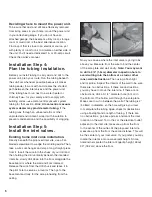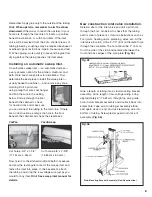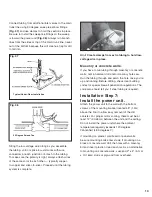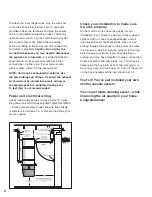
Hint: Create clamps from extra tubing to hold low-
voltage wire in place.
Masonry or concrete walls.
If you have to run tubing through masonry or concrete
walls, rent a hammer drill and/or masonry hole saw.
Run the tubing through and patch the hole once you’re
up and running. Before drilling, check local building
codes for special fi rewall penetration regulations. The
code also should tell you if steel tubing is required.
Installation Step 7:
Install the power unit.
Attach the power unit to the wall with the bottom
screws of the mounting bracket located 48" (1.2m)
above the fl oor to allow easy removal of the dirt
canister. For proper motor cooling, there must be at
least 12" (30.48cm) between the unit and the ceiling.
Do not install the power unit where the ambient
temperature regularly exceeds 120 degrees
Fahrenheit (48.9 degrees C).
If mounting on plaster, wall board or panel walls,
be sure mounting bolts enter studs. If mounting on a
block or concrete wall, drill the holes with a masonry
bit and insert plastic or lead anchors. As an alternative
to mounting on concrete walls, suspend 2" x 4" (5.1cm
x 10.16cm) studs or plywood from overhead.
Connect tubing from additional inlet valves to the main
trunk line using 90 degree sweep tee elbow fi ttings.
(Fig. 07)
and use clamps to hold the sections in place.
Be sure to install the sweep tee fi ttings so the sweep
is toward the power unit
(Fig. 08)
. Always run branch
lines from the sides or top of the main trunk line, never
out of the bottom because this will create a trap for dirt
to fall into.
String the low-voltage wire along as you assemble
the tubing. Join or splice low-volt wires with wire
connectors at each junction or branch in the tubing.
To make sure the polarity is right, always attach wires
of the same color to each other — typically copper-
to-copper and silver-to-silver. Proceed until the tubing
system is complete.
Fig. 07
Fig. 08
90 Degree Sweep Tee
Typical Under-Floor Installation
10
Summary of Contents for Quiet Clean PU3650
Page 1: ......
































